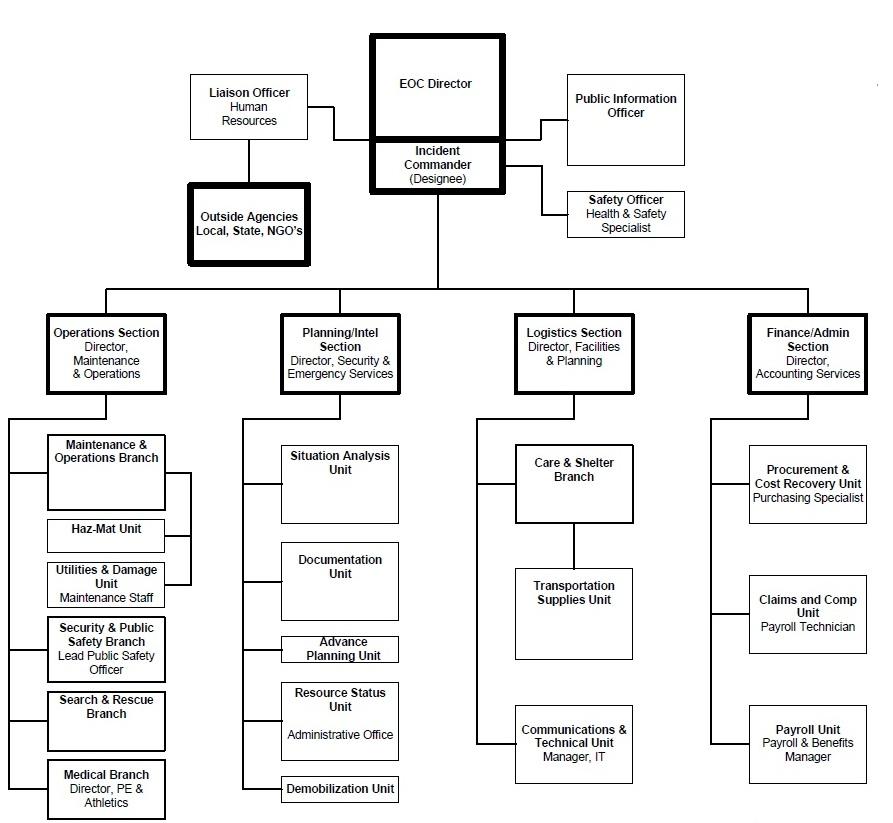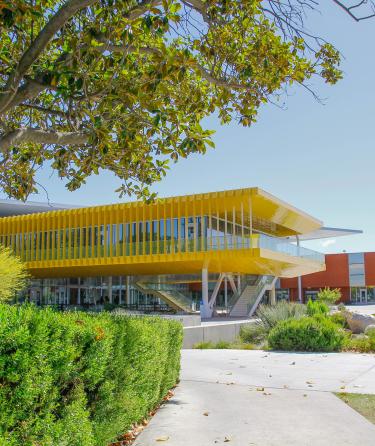EOC ORGANIZATION AND RESPONSIBILITIES
Los Angeles Valley College operates under the ICS emergency management structure discussed in detail in LAVC Emergency Operations Plan. The emergency plan complies with the legal stipulations of the State of State of California Code of Regulations, Title 19, Division 2, which contain provisions relevant to emergency response.

EOC RESPONSIBILITIES
The basic EOC organizational structure consists of five Sections (functions) which normally would be activated for a major incident: Management, Operations, Planning, Logistics, and Finance. Checklists are provided for Section Chiefs and each individual position in the organization chart. Section Chiefs should hand out the checklists to their staff upon arrival in the EOC. Section Chiefs are responsible for ensuring all responders read and follow their position checklists.
The Policy/Advisory group is made up of the Los Angeles Valley College President and LAVC Board of Governors who provide executive level policies relating to the emergency response; promote and enhance multi-jurisdictional coordination; coordinate information; and make requests to city, county and state governments. The Policy/Advisory group coordinates decisions and information directly with the Director of Emergency Services.
The Management Section is headed by the Director of Emergency Services (Vice President Administration) who has overall management responsibility for the incident. The director provides emergency policy and ensures effective coordination through the joint efforts of governmental agencies and private organizations. The Management Section staff handles such matters as legal advice, public information, safety, and interagency liaison.
The Management Section staff may consist of:
- Director of Emergency Services – Vice President Administration
- Public Information Officer – Public Relations Manager
- Emergency Management Coordinator – Facilities Manager
- Liaison Officer(s) – Facilities Manager
The Operations Section is headed by an Operations Section Chief who coordinates all College strategic field operations. The Operations Section provides key strategic objectives and priorities to the Planning Section for the completion and implementation of the Los Angeles Valley College EOC Action Plan. In multi-discipline incidents, the Operations Section Chief may have deputies or assistants. The Operations Section is subdivided into Units depending on the needs of the incident.
The EOC Operations staff may consist of:
- Operations Section Chief – Associate Vice President - Administration
- Law Enforcement Fire/Rescue Unit Leader – Duty Deputy (LASD)
- Environmental Health and Safety – General Foreman
- Facilities Management Unit Leader – Facilities Manager
- Student Coordination Unit Leader – Vice President Student Services
- Parent Coordination Unit Leader – Vice President Student Services
- First Aid/Medical Unit Leader – Athletic Trainer
The Planning Section is headed by the Planning Section Chief and is structured into Units depending on the needs of the incident. The Planning Section manages EOC message distribution; collects, analyzes, and displays damage assessment and response data regarding emergency operations; conducts planning meetings; collects, disseminates and maintains EOC documentation; and for extended operations, coordinates the development and distribution of the Los Angeles Valley College EOC Action Plan.
The Planning staff may consist of:
- Planning Section Chief – Vice President Academic Affairs
- Documentation Unit Leader – Admin Secretary - Academic Affairs
- Situation Status Unit Leader – Sr. Office Assistant - Sheriff Office
- Damage Assessment Unit Leader – Plant Facilities Secretary
- Recovery Unit Leader – Chief Fiscal Administrator
The Logistics Section is headed by the Logistics Section Chief who is responsible for providing facilities, services, personnel, equipment, and tracking the status of resources and materials in support of the incident.
The Logistics staff may consist of:
- Logistics Section Chief – Executive Assistant to the President
- Personnel Unit Leader – Community Services Manager
- Purchasing/Supply Unit Leader – Purchasing Agent
- Communications Unit Leader – Electronics Technician
- Transportation Unit Leader – Electronics Technician
- Care and Shelter Unit Leader – Dean - Academic Affairs
The Finance Section is headed by the Finance Section Chief who maintains emergency related expenditure records using a Disaster Accounting System to track personnel and equipment time; provide payments to vendors for supplies and equipment usage; manage claims against the College; and to coordinate tasks associated with state and FEMA disaster recovery. This Section can include Cost, Time and Recovery Units.
The Finance staff may consist of:
- Finance Chief – Chief Fiscal Administrator
- Cost Unit Leader – Sr. Accounting Technician
- Time Unit Leader – Payroll Supervisor
EMERGENCY OPERATIONS CENTER (EOC)
An EOC is a location from which centralized emergency management can be performed during a major emergency or disaster. The primary Los Angeles Valley College EOC is located in the Childcare Center. The alternate EOC is located at the LAVC Presidents Conference Room. These facilities will be used for coordinating the Los Angeles Valley College emergency response by the Director of Emergency Services, emergency response staff, and representatives from outside agencies or districts.
An EOC provides a central location of authority and information, and allows for face‑to‑face coordination among personnel who must manage the College emergency response.
- Managing and coordinating emergency operations
- Receiving and disseminating warning information
- Developing emergency policies/procedures
- Collecting intelligence from and disseminating information to the various EOC representatives as well as adjacent cities and the county
- Preparing intelligence/information summaries, situation reports, operational reports, action plans, and other reports as required
- Maintaining general and specific maps, information display boards, and other data pertaining to emergency operations
- Analysis and evaluation of all data pertaining to emergency operations
- Controlling and coordinating the operational and logistical support of College resources committed to the emergency
- Maintaining contact and coordination with local government EOCs
- Providing emergency information and instructions to the Los Angeles Valley College student body, faculty, and staff, making official releases to the news media, and scheduling press conferences
EOC PROCEDURES
EOC set-up is the responsibility of the Operations Chief and/or the College Director of Facilities supported by the EOC staff. However, if representatives from the Police Department are not available, the first personnel arriving in the EOC should commence setup. (EOC Activation Checklists and EOC Diagrams are at the end of this Section)
One of the EOC’s major purposes is the accumulation, verification, and sharing of information to ensure a coordinated, timely response. To facilitate the display and tracking of key information laminated status charts and maps are stored at EOC. Each Section Chief is responsible for the accurate and timely display of information within their section. All display charts, white boards, and materials such as colored markers and administrative supplies are stored in the facilities department. Each Section is responsible to determine specific display needs (such as utility schematics or other department specific information) and maintain accurate and up-to-date information on the charts and maps.
The Director or Emergency Services (Vice President, Administrative Services) and/or the Operations Chief is responsible for the operational readiness and maintenance of the primary Los Angeles Valley College EOC. They will also coordinate readiness and maintenance of alternate EOCs facilities.
The Director of Emergency Services will establish the duration of operational periods. Based on the tactical situation, operational periods may be extended to twelve hour periods to meet response requirements. Relief shifts should arrive 30 minutes before the start of their shift so that briefings can be conducted on what has occurred, on what decisions have been reached, and on what problems remain unaddressed.
Operational briefings for the Director of Emergency Services and Public Information Officer should be scheduled at 2 to 4 hour intervals. Briefings for the Policy/Advisory Group should be scheduled on a 6 to 12 hour interval based on the situation. An Action Plan Meeting should be scheduled by the Planning Section Chief during each operational period. The Planning Section is responsible for coordinating all briefings and planning meetings. The Public Information Officer will schedule briefings for the news media on an as required basis (based on the tactical situation). Section Chiefs will prepare summaries for briefings and meetings to include:
- Los Angeles Valley College solved problems
- Major new problems during previous 6 hours
- Anticipate problems and required support for the next operational period
- Assistance needed from other agencies and status of mutual aid
- Information developed by Section that should be passed to other EOC sections
MOBILE COMMAND POST
Los Angeles Valley College has an emergency response vehicle (former college police car) that is equipped with Sheriff’s and Plant Facilities radios, and a loudspeaker system. This vehicle may be used for response to locations which have sustained a smaller, localized emergency where the use of a Mobile Command Post is appropriate such as a building fire or hazardous chemical spill, etc. The vehicle is equipped with a large scale campus map and other general emergency equipment in the trunk (mostly first aid equipment). The Mobile Command Post greatly enhances our response to emergencies on campus and it allows us to coordinate with the Sheriff and Plant Facilities and efficiently direct our operations in a field environment.
